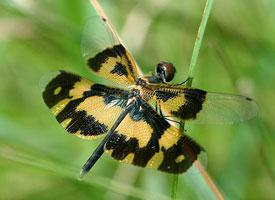
Súlyok és méretek
| Hossz | 38-tól 39-ig mm |
|---|
Állatleírás
The Scarlet Dragonfly (Crocothemis erythraea) is a striking species of dragonfly belonging to the family Libellulidae, known for its vibrant coloration and widespread distribution across various regions. This species exhibits a remarkable presence, primarily due to the male's brilliant scarlet-red body, which serves as a vivid emblem of the warm habitats it frequents. The Scarlet Dragonfly has garnered attention not only from entomologists but also from nature enthusiasts who are captivated by its dazzling appearance and intriguing behaviors.Adult males of this species are easily identifiable by their bright red abdomen and thorax, which contrast sharply with their darker wing bases. The wings themselves are mostly transparent, with a slight amber tint near the body, further accentuating the dragonfly's vivid coloration. Females and immature males, however, present a more subdued palette, featuring a golden-yellow to olive-green hue, which gradually transitions to the characteristic red as they mature.
The Scarlet Dragonfly has a robust and medium-sized body, typically measuring between 35 to 45 millimeters in length. Its eyes are large and compound, providing a wide field of vision essential for detecting prey and avoiding predators. The legs are black, spiny, and well-adapted for grasping, enabling it to catch prey in flight with remarkable efficiency.
This species is predominantly found in warm and temperate regions, thriving in a variety of freshwater habitats. These include ponds, lakes, slow-flowing rivers, and marshes, where there is an abundance of vegetation. The Scarlet Dragonfly prefers areas with exposed, sunny spots for basking and territories rich in aquatic vegetation that supports a healthy population of prey items.
The life cycle of the Scarlet Dragonfly, like other dragonflies, involves a fascinating transformation from water-bound nymphs to agile aerial adults. The nymphs are aquatic predators, feeding on a variety of smaller aquatic organisms until they undergo metamorphosis. This stage of their life can last up to two years, depending on environmental conditions. The adult phase, in contrast, is considerably shorter, typically spanning a few months, during which mating and reproduction take precedence.
Mating involves a unique aerial display, where the male grasps the female by the neck using claspers at the end of his abdomen, forming a mating wheel. After fertilization, the female lays eggs by dipping her abdomen into the water while still in flight, dispersing them across the water's surface. These eggs will hatch into nymphs, continuing the cycle of life.
The Scarlet Dragonfly is not only a marvel of nature's design but also plays a crucial role in the ecosystems it inhabits. As both predator and prey, it helps maintain the balance of aquatic and terrestrial food webs. Its presence and population health can also serve as indicators of environmental quality, making it a species of interest for conservation efforts.
Despite facing threats from habitat loss and pollution, the Scarlet Dragonfly remains a resilient and adaptable species. Its widespread distribution and ability to colonize new habitats have enabled it to persist in changing environments. Observing these radiant creatures in their natural habitats offers a glimpse into the intricate interconnections of ecosystems and the enduring beauty of the natural world.
Hasonló állatok
Új állatfotók
Top 10 állat
- Dolphin gull (Leucophaeus scoresbii)
- Japanese macaque (Macaca fuscata)
- Stone loach (Barbatula barbatula)
- Russian tortoise (Testudo horsfieldii)
- Galápagos tortoise (Geochelone nigra complex)
- Greek tortoise (Testudo graeca)
- Diana monkey (Cercopithecus diana)
- Common flying dragon (Draco volans)
- Moustached guenon (Cercopithecus cephus)
- Galápagos penguin (Spheniscus mendiculus)


